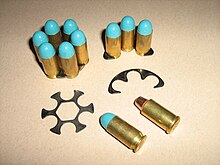
A firearm is any type of gun that uses an explosive charge and is designed to be readily carried and used by an individual. The term is legally defined further in different countries.

A revolver is a repeating handgun that has at least one barrel and uses a revolving cylinder containing multiple chambers for firing. Because most revolver models hold up to six cartridges, before needing to be reloaded, revolvers are commonly called six shooters or sixguns. Due to their rotating cylinder mechanism, they may also be called wheel guns.

A semi-automatic rifle is an autoloading rifle that fires a single cartridge with each pull of the trigger and uses part of the fired cartridge's energy to eject the case and load another cartridge into the chamber. In contrast, a bolt-action rifle requires the user to cycle the bolt manually before they can fire a second time, and a fully automatic rifle fires continuously until the trigger is released.

A cartridge, also known as a round, is a type of pre-assembled firearm ammunition packaging a projectile, a propellant substance and an ignition device (primer) within a metallic, paper, or plastic case that is precisely made to fit within the barrel chamber of a breechloading gun, for convenient transportation and handling during shooting. Although in popular usage the term "bullet" is often used to refer to a complete cartridge, the correct usage only refers to the projectile.

In firearms terminology, an action is the functional mechanism of a breech-loading firearm that handles the ammunition cartridges, or the method by which that mechanism works. Actions are technically not present on muzzleloaders, as all those are single-shot firearms with a closed off breech with the powder and projectile manually loaded from the muzzle. Instead, the muzzleloader ignition mechanism is referred to as the lock.
A semi-automatic firearm, also called a self-loading or autoloading firearm, is a repeating firearm whose action mechanism automatically loads a following round of cartridge into the chamber and prepares it for subsequent firing, but requires the shooter to manually actuate the trigger in order to discharge each shot. Typically, this involves the weapon's action utilizing the excess energy released during the preceding shot to unlock and move the bolt, extracting and ejecting the spent cartridge case from the chamber, re-cocking the firing mechanism, and loading a new cartridge into the firing chamber, all without input from the user. To fire again, however, the user must actively release the trigger, allow it to "reset", before pulling the trigger again to fire off the next round. As a result, each trigger pull only discharges a single round from a semi-automatic weapon, as opposed to a fully automatic weapon, which will shoot continuously as long as the ammunition is replete and the trigger is kept depressed.

A breechloader is a firearm in which the user loads the ammunition from the breech end of the barrel, as opposed to a muzzleloader, in which the user loads the ammunition from the (muzzle) end of the barrel.
A repeating rifle is a single-barreled rifle capable of repeated discharges between each ammunition reload. This is typically achieved by having multiple cartridges stored in a magazine and then fed individually into the chamber by a reciprocating bolt, via either a manual or automatic action mechanism, while the act of chambering the round typically also recocks the hammer/striker for the following shot. In common usage, the term "repeating rifle" most often refers specifically to manual repeating rifles, as opposed to self-loading rifles, which use the recoil, gas, or blowback of the previous shot to cycle the action and load the next round, even though all self-loading firearms are technically a subcategory of repeating firearms.

A magazine, often simply called a mag, is an ammunition storage and feeding device for a repeating firearm, either integral within the gun or externally attached. The magazine functions by holding several cartridges within itself and sequentially pushing each one into a position where it may be readily loaded into the barrel chamber by the firearm's moving action. The detachable magazine is sometimes colloquially referred to as a "clip", although this is technically inaccurate since a clip is actually an accessory device used to help load ammunition into a magazine or cylinder.
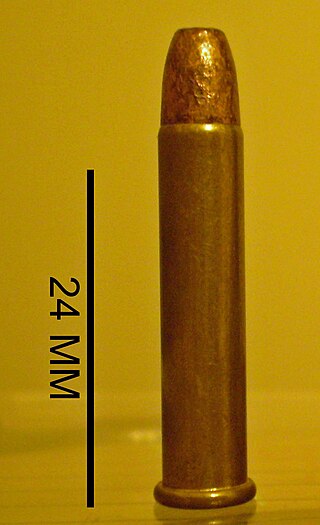
The .22 Winchester Magnum Rimfire, also known as the .22 WMR, .22 Magnum, .22 WMRF, .22 MRF, or .22 Mag, is a rimfire cartridge. Originally loaded with a bullet weight of 40 grains (2.6 g) delivering velocities in the 2,000 feet per second (610 m/s) range from a rifle barrel, .22 WMR is now loaded with bullet weights ranging from 50 grains (3.2 g) at 1,530 feet per second (470 m/s) to 30 grains (1.9 g) at 2,200 feet per second (670 m/s).
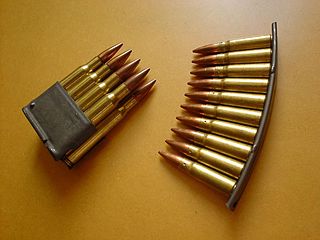
A clip is a device that is used to store multiple rounds of ammunition together as a unit for insertion into the magazine or cylinder of a firearm. This speeds up the process by loading the firearm with several rounds at once, rather than one at a time. There are several types, most made of inexpensive stamped sheet metal, intended to be disposable, though they are often re-used.
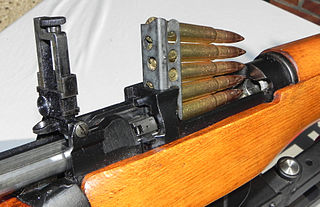
A stripper clip is a speedloader that holds several cartridges together in a single unit for easier and faster loading of a firearm magazine.
A rim is an external flange that is machined, cast, molded, stamped, or pressed around the bottom of a firearms cartridge. Thus, rimmed cartridges are sometimes called "flanged" cartridges. Almost all cartridges feature an extractor or headspacing rim, in spite of the fact that some cartridges are known as "rimless cartridges". The rim may serve a number of purposes, including providing a lip for the extractor to engage, and sometimes serving to headspace the cartridge.

A moon clip is a ring-shaped or star-shaped piece of metal designed to hold multiple cartridges together as a unit, for simultaneous insertion and extraction from a revolver cylinder. Moon clips may either hold an entire cylinder's worth of cartridges together, half a cylinder, or just two neighboring cartridges. The two-cartridge moon clips can be used for those revolvers that have an odd number of loading chambers such as five or seven and also for those revolvers that allow a shooter to mix both rimless and rimmed types of cartridges in one loading of the same cylinder.

Break action is a type of firearm action in which the barrel(s) are hinged much like a door and rotate perpendicularly to the bore axis to expose the breech and allow loading and unloading of cartridges. A separate operation may be required for the cocking of a hammer to fire the new round. There are many types of break-action firearms; break actions are universal in double-barreled shotguns, double-barreled rifles, combination guns, and are commonly found in single shot pistols, rifles, shotguns, including flare guns, grenade launchers, air guns, and some older revolver designs. They are also known as hinge-action, break-open, break-barrel, break-top, or, on old revolvers, top-break actions.
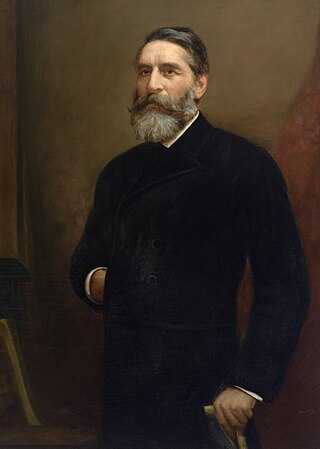
James Paris Lee was a British Canadian inventor and arms designer. He is best known for having invented the Lee Model 1879 rifle, which is the first bolt-action detachable box magazine fed rifle. These features would be incorporated into more successful repeating rifle designs later on, such as in the Lee–Metford and Lee–Enfield rifle series.

In firearms, the cylinder is the cylindrical, rotating part of a revolver containing multiple chambers, each of which is capable of holding a single cartridge. The cylinder rotates (revolves) around a central axis in the revolver's action to sequentially align each individual chamber with the barrel bore for repeated firing. Each time the gun is cocked, the cylinder indexes by one chamber. Serving the same function as a rotary magazine, the cylinder stores ammunitions within the revolver and allows it to fire multiple times before needing to reload.
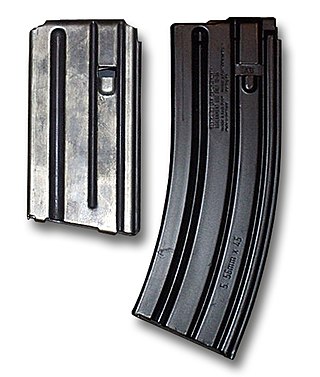
A STANAG magazine or NATO magazine is a type of detachable firearm magazine proposed by NATO in October 1980. Shortly after NATO's acceptance of the 5.56×45mm NATO rifle cartridge, Draft Standardization Agreement (STANAG) 4179 was proposed in order to allow NATO members to easily share rifle ammunition and magazines down to the individual soldier level. The U.S. M16 rifle's magazine proportions were proposed for standardization. Many NATO members, but not all, subsequently developed or purchased rifles with the ability to accept this type of magazine. However, the standard was never ratified and remains a "Draft STANAG".
The following are terms related to firearms and ammunition topics.
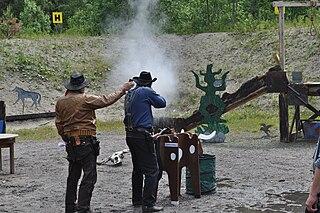
Cowboy action shooting is a competitive shooting sport that originated in the early 1980s, at the Coto de Caza Shooting Range in Orange County, California. Cowboy action shooting is now practiced in many places with several sanctioning organizations including the Single Action Shooting Society (SASS), Western Action Shootists Association (WASA), and National Congress of Old West Shooters (NCOWS), and Single Action Shooting Australia (SASA).


